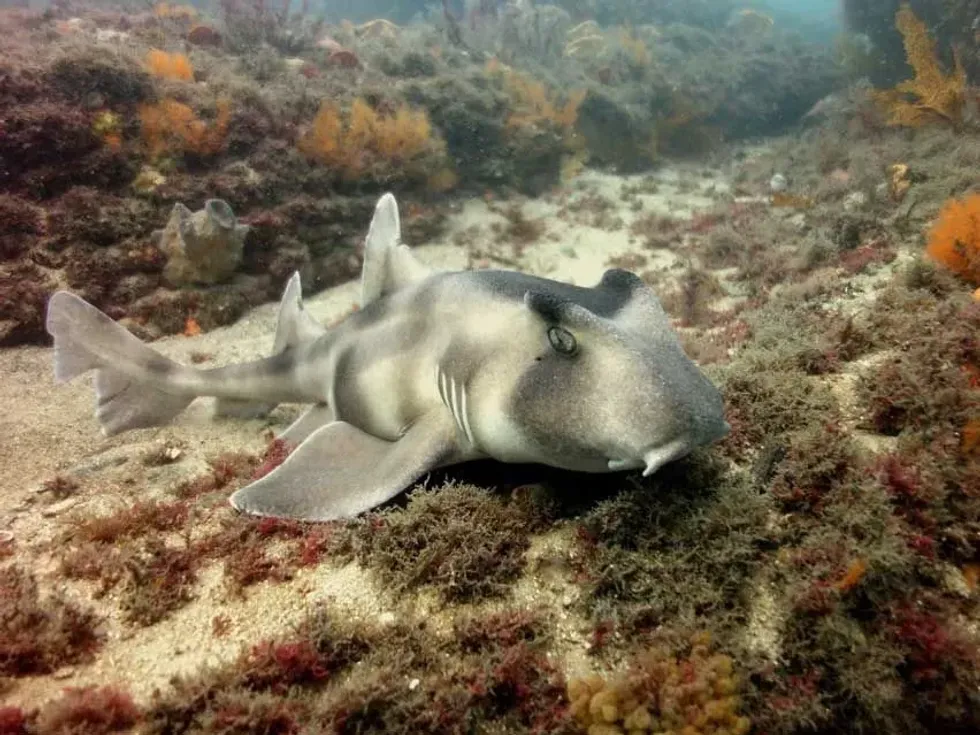There are 1000 species of sharks and there is so far one species of horn shark. The Mexican hornshark, Heterodontus mexicanus, is also popularly known as the bullhead shark. They are unique species with spots all over.
They are inshore sharks and relatively small in size as compared to other species of sharks. They move using their dorsal, pectoral fin, and tail. They belong to the family Heterodontidae, and genus Heterodontus.
In various part of the world like in Mexico, horn sharks are consumed as food although they are often caught mistakenly and in other regions like California, the larger horn shark spines are made into jewelry. They are seen in regions of the Eastern Pacific, Gulf of California, Columbia, and Panama.
They are seen at the bottom levels of the water body near coral reefs and rocky or sandy areas. If touched they are often prone to bite or try to attack divers however, they pose no other major threat to humans.
Their locomotion is relatively slow as compared to other species of sharks. For more relatable content, check out these channel catfish facts and rainbow trout facts.
Mexican Hornshark Interesting Facts
What type of animal is a Mexican hornshark?
Mexican horn, shark heterodontus mexicanus, is a type of shark that belongs to the kingdom Animalia and order Heterodontiformes.
What class of animal does a Mexican hornshark belong to?
The Mexican hornshark, heterodontus mexicanus, is a type of fish that belongs to class Chondrichthyes, family Heterodontidae, and genus Heterodontus, and order Heterodontiformes.
How many Mexican hornsharks are there in the world?
The Mexican horn shark's exact population is not estimated, however, they are prone to be hunted illegally, and used for commercial purposes. Almost 100 million sharks were killed in the year 2000. Their distribution is impacted due to various illegal activities and habitat loss.
Where does a Mexican hornshark live?
Mexican horn sharks live in sandy areas in the ocean and the sea. They live in regions including the Eastern Pacific, Gulf of California, Columbia, and Panama. Their scientific name is heterodontus mexicanus.
What is a Mexican hornsharks habitat?
Mexican hornsharks reside in inshore regions at depths of 165 ft (50 m). They prefer rocky terrains, seamounts, coral reefs, and sandy regions in oceans and seas.
Who do Mexican hornsharks live with?
Mexican horn sharks are solitary beings, however, they coexist with other wild species. They reside in rocky terrains in the sea. They come together only for mating.
How long does a Mexican hornshark live?
Mexican horn sharks may have an average life expectancy range is of 25 years and may also live up to 50 years. They reside in the same region for most of their life and are rarely seen in other regions.
How do they reproduce?
Little information exists about the reproduction process of adult horn shark fish. Mexican hornsharks are oviparous in nature and lay eggs post-mating on rocky terrain they don't build or look for hidden spots to lay their eggs through reproduction. The gestation period is not known.
The incubation period of the egg cases is not known in the case of their reproduction. Egg cases are laid in shallow water in a spiral-shaped egg case formation.
Eggs are laid by multiple other fish species in shallow water. The egg cases are cone-shaped. Some species of sharks are also known to give birth to their young through reproduction, however, the Mexican hornshark doesn't do this.
What is their conservation status?
The Mexican hornshark's conservation status is Near Threatened as per the International Union For Conservation Of Nature (IUCN) i.e. IUCN red list. Their distribution is majorly affected by illegal practices and habitat loss. Information related to the distribution and range map of other species too is available on the IUCN website.
Mexican Hornshark Fun Facts
What do Mexican hornsharks look like?

Please note that this is an image of a Heterodontus francisci, not a Mexican hornshark. If you have an image of a Mexican hornshark at hello@kidadl.com.
Mexican hornsharks, Heterodontus mexicanus, look unique and aesthetically pleasing owing to their features. They have rounded heads with prominent ridges above their eyes.
They are gray-brown and have dotted black spots all over their head and body. They have a conical but blunt head and dark-colored eyes and sharp teeth. They have spines in front of their dorsal fin.
They have pectoral fins which are followed by their first dorsal fin and the second dorsal fin is behind the pelvic fins. Both the from and back of the dorsal fins has fin spines. Their first dorsal fin and their tail help them swim easily by facilitating movement along with their pelvic fins and pectoral fins.
Dorsal fins facilitate movement in other species of fish as well. They are easily spotted in the Pacific ocean and similar habitats.
How cute are they?
Mexican hornsharks are cute species of sharks and attractive in appearance as well. Their behavior is not ideally friendly towards humans however, they can be spotted at the bottom of the water body where their distribution is mostly constituted. They are easy to spot in the Pacific ocean.
How do they communicate?
Mexican hornsharks communicate primarily using pheromones and body language. Communication is relatively less as compared to other species of animals.
How big is a Mexican hornshark?
Mexican horn sharks may reach a maximum length of 19.7-27.6 in (50-70 cm) which is times bigger than cory catfish which is 2.5 -5 in (6.4- 12.4 cm) in maximum.
How fast can a Mexican hornshark swim?
Horn sharks swim at a maximum speed of 5 mph (2.4 kph). They are relatively slow as compared to the fastest shark, the shortfin mako.
How much does a Mexican hornshark weigh?
Mexican hornshark's exact weight has not been evaluated. Male sharks tend to be smaller in size as compared to females in most instances.
What are the male and female names of the species?
Male and female species are not addressed differently. They differ in reproductive functions and their size and appearance have not yet been evaluated.
What would you call a baby Mexican hornshark?
Baby Mexican hornsharks can be called pups, similar to other baby sharks.
What do they eat?
The Mexican hornshark's diet is primarily carnivorous. They feed on crabs, oysters, shrimp, and small fish. Horn shark species are predatory beings and attack using their front teeth. Predators of the horn shark include bigger animals like great white sharks and elephant seals.
Are they dangerous?
No, these species pose no threat to humans however, this does not mean they are devoid of danger. Its best to observe them from a distance since as per their behavior they don't like being petted and are known to bite if touched.
Would they make a good pet?
Sharks, in general, make horrible pets, and although horn shark is visually appealing it's best to keep it in its natural habitat. Their commercial value is $674 to $759.
The commercial value may vary from one region to another. Their commercial value may also be impacted due to market rates don't be disappointed you could visit aquariums where these species have been strategically placed like the Monterey Bay Aquarium in the United States.
Did you know...
Sharks do not have bones. This is unbelievable considering shark species range is so vast. This does not impact their fossilization.
Shark skin feels like sandpaper when brought out on land. It is, however, wet and slimy when it's in the water.
Sharks don't like being flipped over since this pushes them into a state of tonic immobility. This is utilized by most specialists in the field while tending to them.
Sharks have been estimated to exist in the ocean for about 455 million years ago.
Sharks have strong teeth and are identified by them, however, each species of shark has a different type of teeth. The number of teeth may vary as well.
Mexican hornsharks are not poisonous, but they are also not edible for humans.
Why are they called Mexican hornsharks?
The Mexican hornshark is named primarily because it is short. Their name is derived from the Greek word 'heteros' referring to other and 'odous' meaning teeth, which is why their genus is Heteroduntus. They are called Mexican hornsharks primarily due to the fact that they are seen primarily in Mexican water bodies in the Pacific ocean.
What's unique about the Mexican hornshark?
Mexican hornsharks have unique coloration and pattern which is unlike that of other shark species. They are relatively slow in movements but they still are a top predator.
Their snout is round and blurred and other parts of their body differ as well including their fin spines, pectoral fin, dorsal fin, and their second dorsal fin. At first glance, it's easy to mistake hornsharks for other species of fish owing to their size but that is what makes them unique and exotic.
Here at Kidadl, we have carefully created lots of interesting family-friendly animal facts for everyone to discover! Learn more about some other fishes from our hammerhead shark facts and saw shark facts pages.
You can even occupy yourself at home by coloring in one of our free printable shark coloring pages.









